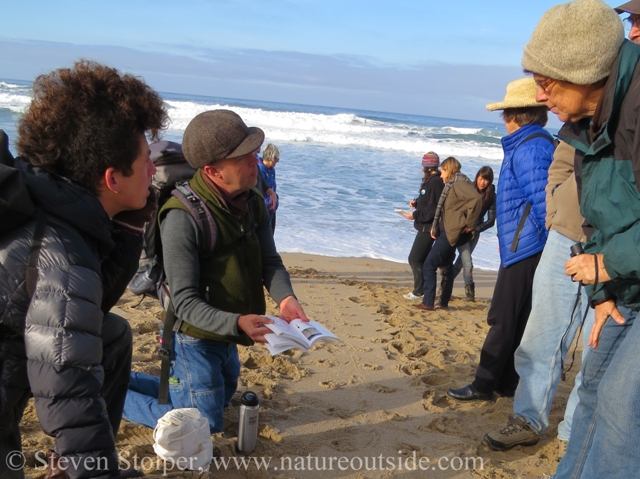
For some, Sundays are about watching football. They plant themselves on the couch in front of the TV with a bowl of salty snacks; Cheering their favorite team while munching their way to coronary heart disease.
For me, the second Sunday of every month means animal tracking with the Bay Area Trackers Club. The group consists of animal trackers and aspiring animal trackers of all ages and abilities. Once a month the group gathers at a local spot to “read the newspaper” of tracks left behind by the local wildlife.
I don’t learn well from books. Some people can read a chapter and instantly assimilate new knowledge or skills. That isn’t me. I learn best when someone explains a concept; When they patiently answer my questions as I construct a mental model from the new information.
That is what makes the Bay Area Trackers so special! The group is full of terrific animal trackers who generously share their time and knowledge. And they make a special effort to welcome newcomers.
I am a big advocate of “hiking with an expert.” Most of my best knowledge of wild edibles, tracking, and firecraft comes from spending dirt time with people I respect. So spending a morning with the Bay Area Trackers is one of my favorite activities.
Growth through Questions
It is better to know some of the questions than all of the answers.
– James Thurber
Two important concepts in tracking require new learners to adjust their thinking:
Ask Questions
When viewing a track there are many unknowns. Posing questions and then seeking answers is essential to increase your knowledge. By asking, considering, and then pursuing you not only learn about the animal you are tracking, you acquire new principles to add to your “tracking toolbox” for next time. It is important for beginners to overcome their fear of appearing foolish and ask as many questions as spring to mind. It is also important to actively exercise your mind by seeking answers.
Some Questions Remain Unanswered
After framing a question it is human nature to want a definitive answer, NOW! When I was growing up, we joked that every problem had to be solved in 30 minutes (the length of a network television show). Today with the internet it’s more like 30 seconds!
An important part of tracking is understanding that questions will remain unanswered. It may take additional thought, it may need research, or it may forever remain a mystery. My initial reaction is often frustration. But coming to terms with this tracking truism frees your mind to explore new avenues without feeling the pressure to arrive at a definitive answer.
That is why I often equate tracking with detective work. There is a mystery to be solved, whether it’s a set of tracks, scat, or even a bloody body.
I want to share with you (in two parts) some of the mysteries the Bay Area Trackers encountered on a recent Sunday morning.
The Beach
We met at 8:00 AM, on a bluff overlooking the beach. Patches of mist hung over the coastline below a clear blue sky. Out to sea, battleship gray stratus clouds loomed low on the horizon, drawing closer with the onshore breeze.
Pescadero State Beach lies alongside the Pacific Coast Highway, about 15 miles south of Half Moon Bay, California. Across the highway is Pescadero Marsh Natural Preserve, a popular spot for bird watchers and others who enjoy nature. It is a refuge for a host of shorebirds, waterfowl, deer, raccoon, fox and skunk.
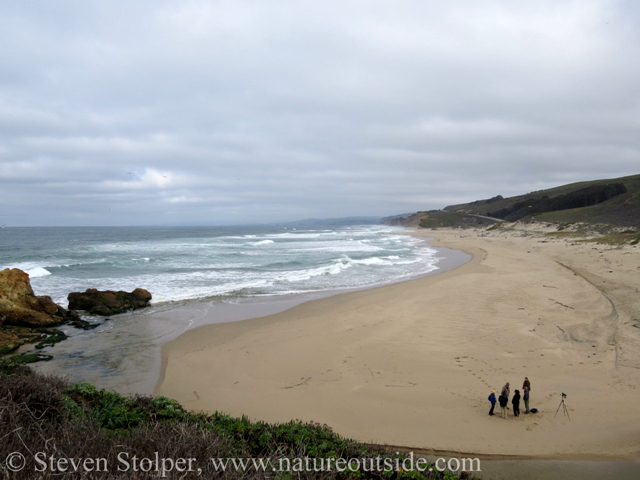
Pescadero State Beach from above. Part of our group is gathered below. (later in the day)
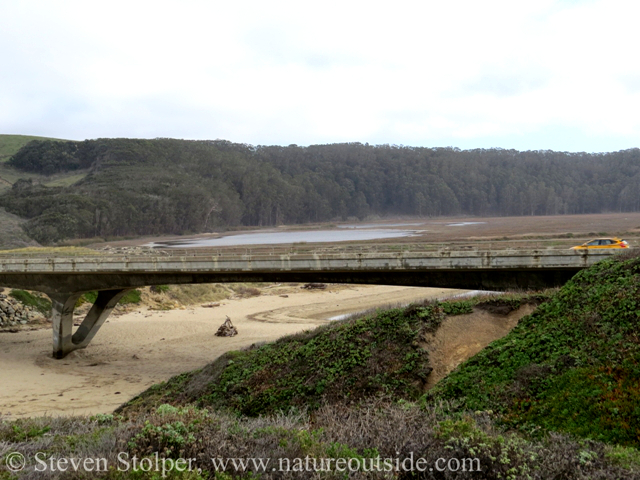
Pescadero Marsh Natural Preserve lies on the other side of the highway.
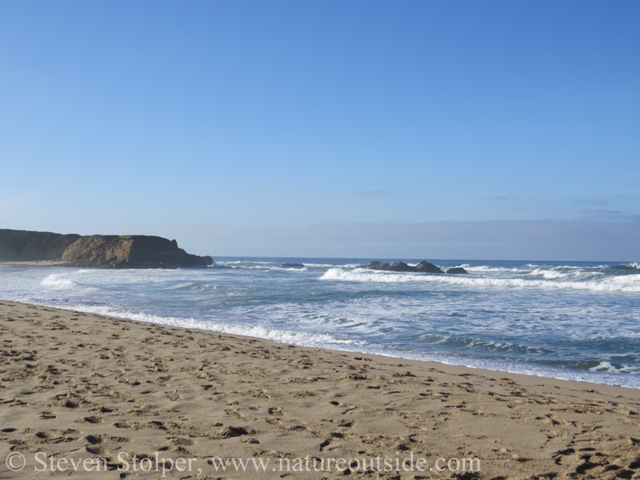
A view from the beach
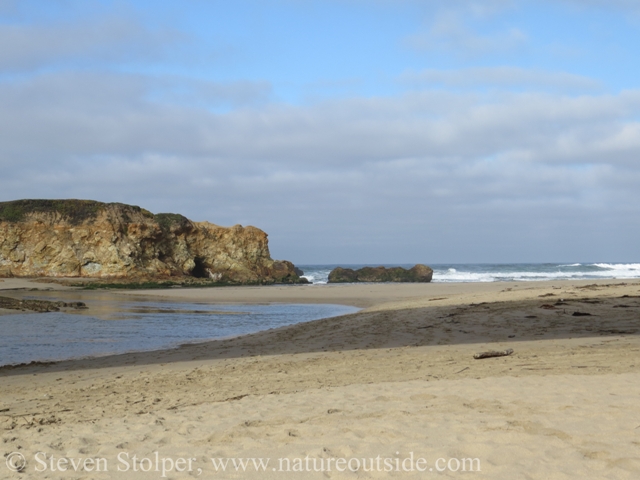
Looking toward the sea from underneath the highway overpass. Pescadero Creek flows over the sand on its way to the ocean.
Holy Molely
Take the attitude of a student, never be too big to ask questions, never know too much to learn something new.
– Og Mandino
As we let ourselves onto the beach from the highway, we immediately noticed a number of strange mounds of sand. Each was about 10-14 inches in diameter and had a smooth appearance broken by a network of fissures.
Several of the trackers plunged hands into the mounds up to their wrists. Some went in from above, others from the side. They were looking for tunnels underneath. These mounds belonged to a decent-sized fossorial animal. But what species? Why would a burrowing animal (rodent or otherwise) come to the beach?
It was unlikely to be a pocket gopher. They are herbivores and there were no plants growing on the flat expanse of sand. But moles (Talpidae) are insectivores. There were plenty of invertebrates, like sand fleas, hopping about on the sand. Several people confirmed from experience that these mounds were made by a mole.
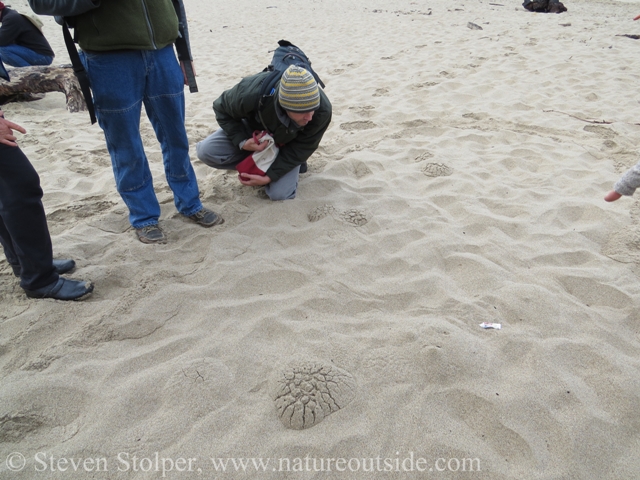
Mole hills in the sand
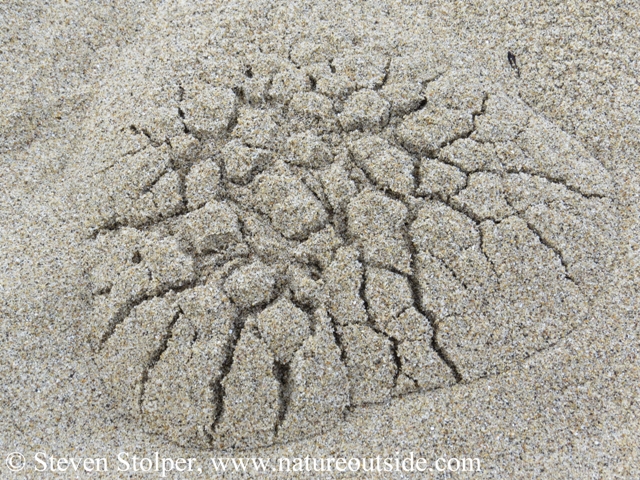
Close-up of a mole hill in the sand
Cooler Drag
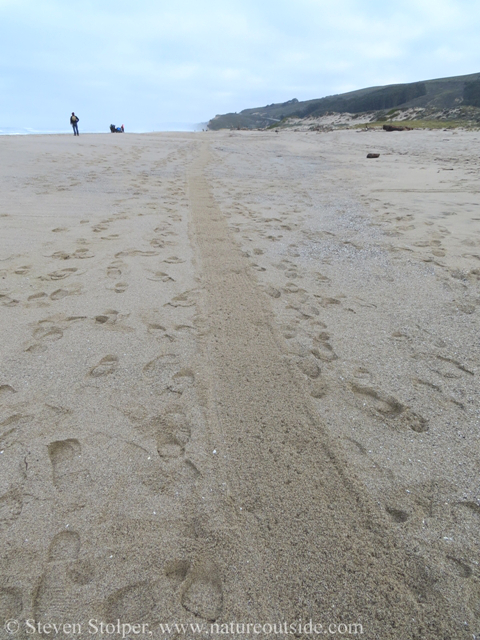
What a strange trail!
What a strange trail! It had extremely straight well-defined edges and ran parallel to the surf. I suspected people made the trail, but followed it to be certain. Eventually it led to an improvised wood shelter. I did not look around the shelter but guessed I would find empties from the cooler someone dragged across the beach. The trail was definitely the result of people (Homo sapiens drinkin beerus).
The Tracks Go In but They Never Come Out…
The wise man doesn’t give the right answers, he poses the right questions.
-Claude Levi-Strauss
The group gathered around the most extraordinary set of tracks. They started at a flat area of sand about 30 yards from the surf. From that spot they moved downhill and disappeared into the water. There were no tracks leading out of the surf!
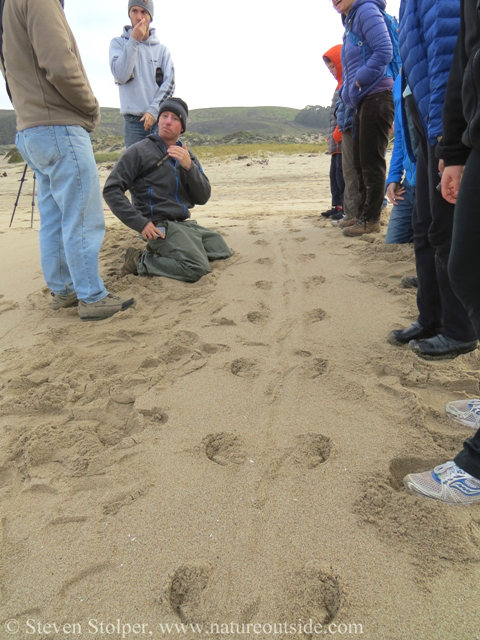
The strange tracks originate from a flat spot higher on the beach.
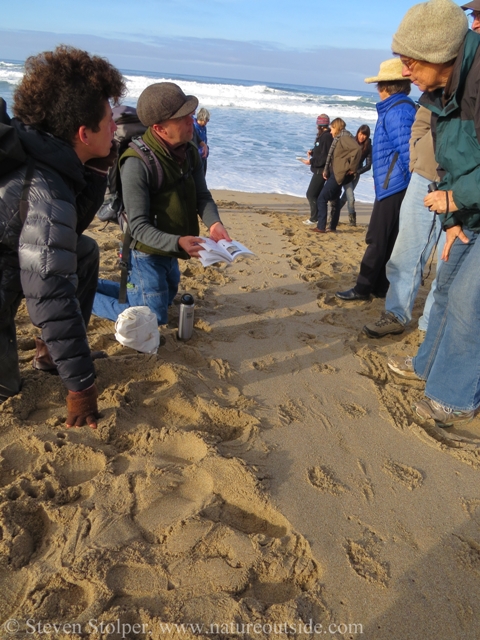
The tracks led into the surf and disappeared.
I had never seen tracks like this. I was so excited! Here was a true mystery that practically guaranteed that I would learn about a “new” animal. I eagerly examined these strange tracks while eavesdropping on the conversation around me.
The tracks were crescent shaped. Was it my imagination or did I see claw marks (at least 4 per track) registering in the sand? What kind of creature has a “foot” like that?
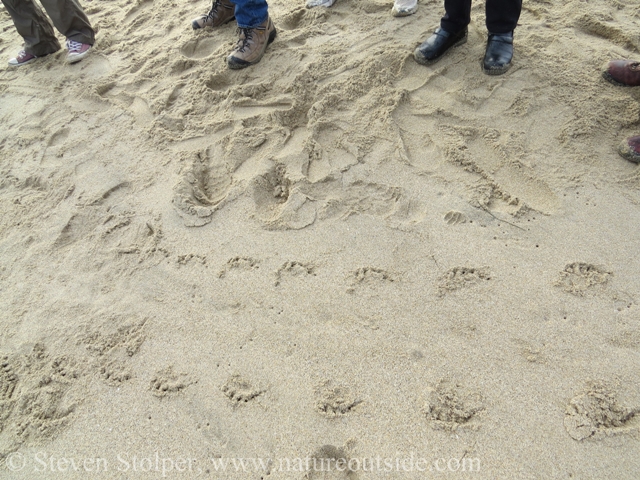
Notice the shape of the tracks, their spacing, and what appears to be a depression running down the center of the trail.
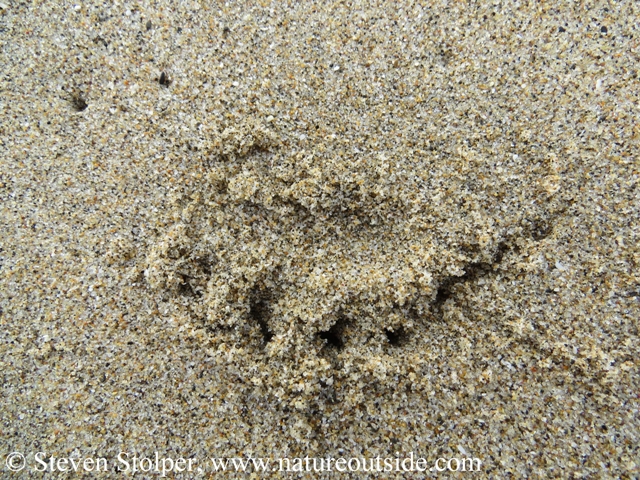
There are at least 4 claw marks registering in the tracks.
Why did the tracks originate at one spot and disappear into the water? And where were the tracks coming out of the water?
Looking at the trail width (the space measured across the animal’s body between the left and the right tracks) we noticed something peculiar. Where the tracks originated, the trail width was 12 inches wide. As the tracks went downhill and approached the water, the trail width shrunk to 7 inches. Trail width usually decreases as speed increases. Try it for yourself. When you walk you are usually “squared up” to your direction of travel. When you run, your feet land more linearly along your line of travel. This implies the animal accelerated as it moved down the beach into the water. Looking at the trail seemed to confirm this. The sets of tracks near the water were farther apart and displaced more sand than the ones above. The animal started slowly and picked up speed into the water.
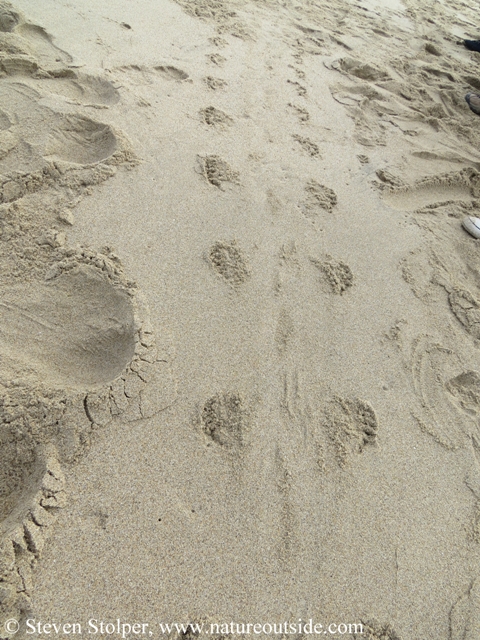
The animal picks up speed as it approaches the bottom of this photograph.
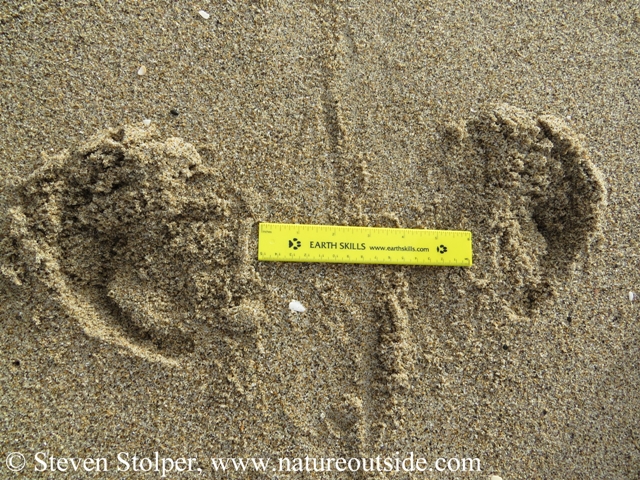
Examining the trail width gave us a clue to how the animal was moving.
From the shape of the tracks, we were beginning to think harbor seal (Phoca vitulina), sea turtle, or baby sea lion (Zalophus Californianus). Sea turtles are ungainly on the beach. They lurch across the sand dragging their plastron (the bottom of their shell) through the sand. Their tracks look very different from what we saw.
This left harbor seal and baby sea lion. Elbroch’s field guide pointed out that harbor seals leave claw marks in the sand. The picture in the book was a spot-on match for what we saw. We were looking at the trail of a harbor seal!
We looked closely at the flat area from where the tracks originated. There was a noticeable depression and a crescent-shaped sheen that might be due to salt. Or, the sand could have been dryer in that spot. This must have been where the harbor seal rested after it hauled-out!
How long was the harbor seal here? Why were there only one set of tracks (into the water)? The spot suggested an answer. If the seal hauled-out before the last high tide receded, the water would have erased the seal’s trail out of the water. The crescent-shaped depression could have been created by water from the high tide receding toward the sea. Have you ever lain on the beach with the waves washing over you? If so, you may recall how water returning to the ocean digs a trough underneath the leading edge of your body. The crescent shape could have been caused by the seal’s body.
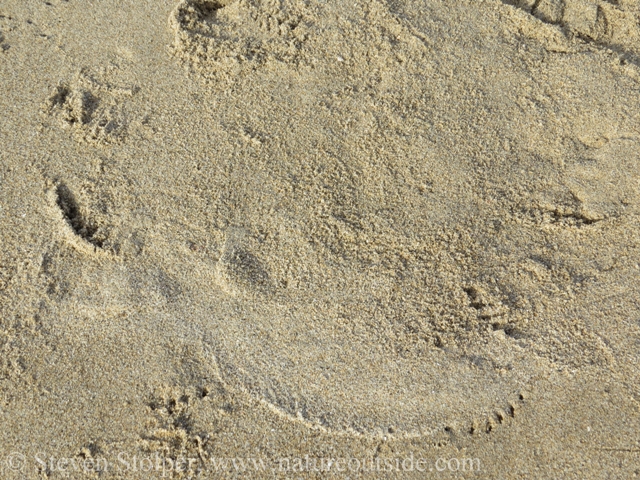
The depression created by the animal’s body
There was other evidence that the seal may have rested here for many hours. There was an abundance of raven tracks nearby. Were these birds coming to see if the seal was in distress? If the seal remained stationary for many hours, it might attract the unwanted attention of corvids looking to scavenge an easy meal.
Sometime after the high tide retreated, the seal stirred. It started slowly and then accelerated downhill into the water. These were the tracks we saw in the sand.
The high tide had begun returning as we examined the tracks. The tracks also looked very recent. It was likely the seal had been at this spot for many hours. Afterward, an eyewitness confirmed our assumption.
What an exciting experience! I now have a “harbor seal” pattern of tracks and behaviors I can use next time.
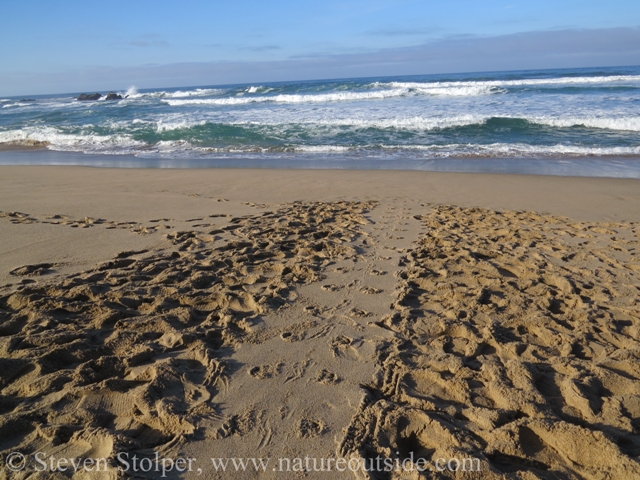
What it looks like after a group of trackers find a set of tracks
More Tracking on NatureOutside
Mysteries on the Beach (Part 2)
Mountain Lion Tracks – Learn to Read Them
Wolves Teach a Master Class (Part 1)
If you enjoyed this article you may like others in the Tracking Section.



Leave a Comment